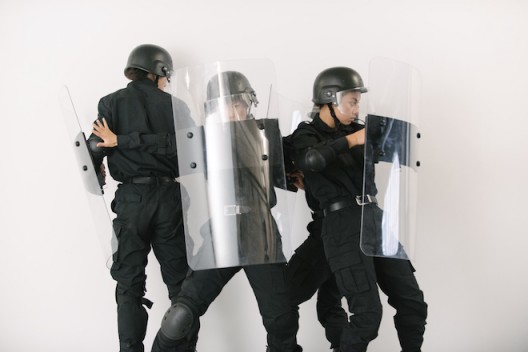Wind
2017 - Sculpture (Sculpture)
220 x 120 x 5 cm
Antonio Pichillá
Wind by Antonio Pichillá is a textile piece depicting the glyph that represents the element wind in the Mayan tradition. It is woven in the four colors of each of the cardinal points which, together, symbolize the entire universe. It is woven mostly with knots that the artist refers to as a “bond between two or more systems that also represents a closure […] the knot in the throat that submerges the voice.” This piece, like other works in Pichillá’s practice, is an attempt to reconcile the Maya Tz’utujil symbolic tradition with Western art historical categories and practices. However, Wind is not simply the representation of the element from a self-referential or celebratory position. Rather, the work is an exploration of language and, by extension, the study of glyphs in ceramics, codices, and other Mayan artifacts, as a metaphor for the appropriation and conservation of Mayan archeological objects in the world’s most famous museums; standing in stark contradiction with prevailing attitudes of colonialism and exploitation towards Indigneous communities, both in and outside of Guatemala. By weaving with knots while referencing geometric abstraction, Pichillá attempts to denounce colonialism, while performing a subtle reconciliatory ritual that might bring solace and peace to a war-pestered relationship.
Antonio Pichillá is an artist from the Maya Tz’utujil tradition who, like many practitioners outside of Western tradition, is also a healer and a spiritual guide in his community. It is from his studio at Lake Atitlán that he looks for a bond that integrates with the environment as something inaccurate and uncodified. The artist’s interdisciplinary practice is driven by anthropological research in both the urban and rural regions of Guatemala. Constructing and intervening in a variety of methods, materials, forms, objects, and rituals, Pichillá’s works are expressions of the everyday that are indexical of temporality. Through an investigation that spans over ten years, Pichilla has strived to bring closer the Indigenous and non-Indigenous populations of Guatemala which, in a country plagued with internalized racism, is not only necessary, but has also invested his work with a political significance.
Colors:
Related works sharing similar palette

© » KADIST
Alexandra Pirici
Furthering Alexandra Pirici’s enquiry into the economy and circulation of artworks, Parthenon Marbles is an immaterial version of the sculptural ensemble embodied by five performers...

© » ARTS EQUATOR
Year In Review: Tracing SG Theatre Together | ArtsEquator Thinking and Talking about Arts and Culture in Southeast Asia ArtsEquator Viewpoints December 10, 2020 ArtsEquator and Centre 42 jointly co-present the fourth edition of Year in Review, an annual discussion and round-up of the performing arts in Singapore...

© » KADIST
Nicolas Bacal
2008Nicolás Bacal uses everyday materials to evoke systems in his sculptures and installations...

© » SLASH PARIS
Porter notre part de la nuit — MAC VAL Musée d'art contemporain du Val-de-Marne — Exposition — Slash Paris Connexion Newsletter Twitter Facebook Porter notre part de la nuit — MAC VAL Musée d'art contemporain du Val-de-Marne — Exposition — Slash Paris Français English Accueil Événements Artistes Lieux Magazine Vidéos Retour Précédent Suivant Porter notre part de la nuit Exposition Techniques mixtes Thu-Van Tran, Novel Without a Title #2, série Novel Without a Title , 2019 Bronze, patine chimique et rehauts colorés — 20 × 167 × 20 cm Collection MAC VAL — Musée d’art contemporain du Val-de-Marne — Acquis avec la participation du FRAM Île-de-France...

© » SLASH PARIS
Laurent Le Deunff — Easter Eggs — Galerie Semiose — Exposition — Slash Paris Connexion Newsletter Twitter Facebook Laurent Le Deunff — Easter Eggs — Galerie Semiose — Exposition — Slash Paris Français English Accueil Événements Artistes Lieux Magazine Vidéos Retour Laurent Le Deunff — Easter Eggs Exposition Dessin, sculpture, techniques mixtes Laurent Le Deunff, vue de l’exposition Easter Eggs, galerie Semiose, Paris Courtesy of the artist & Semiose, Paris — Photo : DR Laurent Le Deunff Easter Eggs Encore 19 jours : 18 novembre → 30 décembre 2023 Les sculptures présentées dans l’exposition Easter Eggs se présentent comme des totems composés d’une suite inattendue d’objets, culturels ou naturels, associés avec une très grande liberté...

© » KADIST
A Remote Viewing workshop with artists Myriam Lefkowitz and Simon Ripoll-Hurier 11:00am to 1:30pm or 2:30pm to 5:00pm In the heart of Silicon Valley in the 1970s, and under the aegis of the CIA, a group of scientists and psychics developed a technique intended to channel extra-sensory perceptions in an effort to produce descriptions of distant targets...

© » ARTS EQUATOR
Weekly Southeast Asia Radar: Why I sing in English; how Cambodian art can survive | ArtsEquator Thinking and Talking about Arts and Culture in Southeast Asia ArtsEquator Radar Nyein Su Wai Kyaw Soe | Frontier March 12, 2020 ArtsEquator’s Southeast Asia Radar features articles and posts about arts and culture in Southeast Asia, drawn from local and regional websites and publications – aggregated content from outside sources, so we are exposed to a multitude of voices in the region...

© » ARTNEWS
Spain Buys Cheesemaker’s 120,000 Piece Collection of Avant-Garde Art – ARTnews.com Skip to main content By Shanti Escalante-De Mattei Plus Icon Shanti Escalante-De Mattei View All March 17, 2022 1:00pm The collector, José María Lafuente Europa Press via AP The Spanish Ministry of Culture confirmed today that it would purchase the impressive archive of avant-garde art collected by prominent Spanish businessman José María Lafuente, reported El País ...

© » KADIST
Lydia Gifford
2011Lydia Gifford composes her work between pictorial expression and its inscription within an exhibition space...











